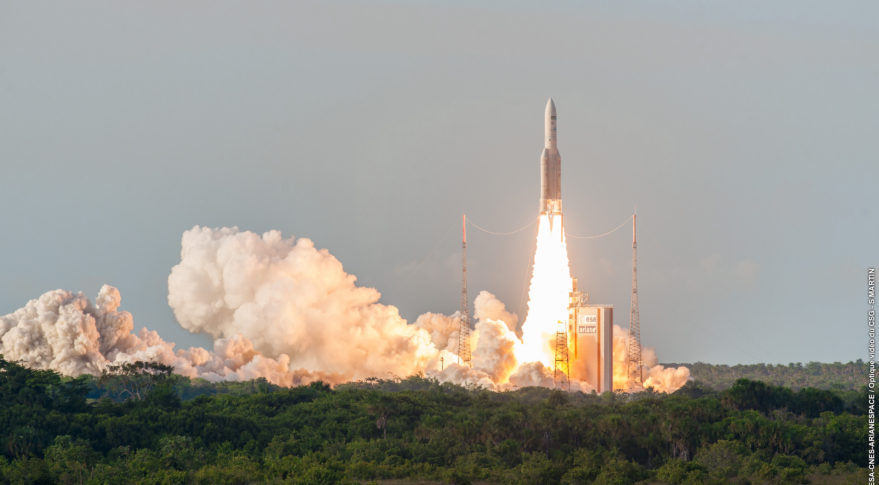Ariane 5, in 74th Straight Success, Launches Australian, Indian Telecom Satellites

KUALA LUMPUR — Europe's Ariane 5 heavy-lift rocket on Oct. 5 successfully placed telecommunications satellites for Australia and India into geostationary-transfer orbit.
Both satellites were reported healthy in orbit by their builders.
Operating from the Guiana Space Center, a French overseas department on the northeast cost of South America, the Ariane 5 vehicle posted its 74th consecutive success, equaling the record of its predecessor, Ariane 4, which was retired in 2003.
The Ariane 5's own successor, Ariane 6, recently won full development approval from European Space Agency governments and is scheduled to perform is inaugural flight in 2020 from is own launch pad, now under construction. Under current thinking, Ariane 5 would continue to operate alongside Ariane 6 for three years before being retired.
The Oct. 5 flight, the fifth of 2016 for Ariane 5, carried the Sky Muster 2 Ka-band consumer broadband satellite, to be operated by Australia's NBN Co. as part of the nation's national broadband rollout. The broadband program, including cable, terrestrial wireless and satellite delivery platforms, remains the most thorough, and the most expensive, of any national broadband deployment program.
Sky Muster 2, weighing 6,404 kilograms at launch, is the second of two Sky Muster satellites, both built by Space Systems Loral of Palo Alto, California. The first was launched in September 2015.
The two satellites are designed to deliver a combined 135 gigabits per second of throughput throughout Australian territory to users in locations specially designated for satellite service. Each delivers 16.4 kilowatts of power to its payload.
Get the Space.com Newsletter
Breaking space news, the latest updates on rocket launches, skywatching events and more!
Occupying the Ariane 5 rocket's upper berth as the heavier of the two passengers, Sky Muster 2 was released into orbit and was reported healthy and sending signals by Space Systems Loral.
India's GSat-18, in Ariane 5's lower berth, is an Indian Space Research Organization I-3K model. Weighing 3,404 kilograms at launch, GSat-18 carries 48 C-, extended-C and Ku-band transponders. It is designed to operate for 15 years from 74 degrees east in geostationary orbit. It can generate 6.5 kilowatts of power to its payload.
This story was provided by SpaceNews, dedicated to covering all aspects of the space industry.
Join our Space Forums to keep talking space on the latest missions, night sky and more! And if you have a news tip, correction or comment, let us know at: community@space.com.
Peter B. de Selding is the co-founder and chief editor of SpaceIntelReport.com, a website dedicated to the latest space industry news and developments that launched in 2017. Prior to founding SpaceIntelReport, Peter spent 26 years as the Paris bureau chief for SpaceNews, an industry publication. At SpaceNews, Peter covered the commercial satellite, launch and international space market. He continues that work at SpaceIntelReport. You can follow Peter's latest project on Twitter at @pbdes.










